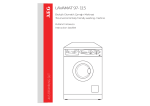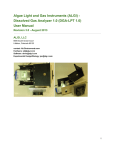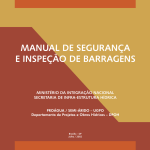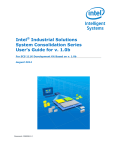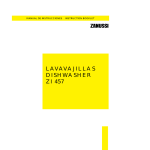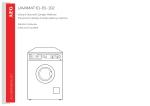Download AEG 34350 I Dishwasher User Manual
Transcript
FAVORIT 403 Dishwasher Operating instructions Contents Safety instructions Disposing of packaging and old machine Disposing of the packaging Disposing of your old machine Important hints Operating your dishwasher economically and with regard for the environment Unsuitable crockery Suitable crockery Description of the appliance The inside of the appliance Use Control panel Washing programmes Before using your dishwasher for the first time Setting the water hardness range Filling with special salt The rinse aid Setting the rinse aid quantity to be added Adding dishwashing detergent Loading your machine The lower basket Cutlery basket The upper basket Operating instructions Care instructions Internal and external cleaning Cleaning the central filter Cleaning the large filter Servicing Customer service Technical data Installing Connecting the water supply Water outlet connection Electrical connection 2 3 5 5 5 6 6 6 7 8 8 9 9 10 12 12 13 14 15 16 18 18 19 20 21 22 22 22 23 24 26 27 28 29 30 31 Safety instructions The safety of AEG electrical appliances conforms to accepted rules of technology and the Appliance Safety Act. We as manufacturers, however, see ourselves as being obliged to familiarise you with the following safety instructions. Using your dishwasher for its intended purpose ● Only use your dishwasher for machine washing of household crockery. If your machine is misused or used for any purposes other than that for which it is intended, the manufacturer cannot be held liable for any damage caused. ● For safety reasons, you should not convert or modify your dishwasher in any way. Before using your dishwasher for the first time ● Check your dishwasher for any transport damage. Never connect a damaged machine. If your dishwasher is damaged, you should contact your supplier. ● Your dishwasher must be correctly installed and connected. Please read the section on "Installation" to make sure you know all about this. ● Before using your dishwasher for the first time, do not forget that the nominal voltage and current type indicated on the rating plate of your machine must be the same as the nominal voltage and current type at the installation site. The necessary electrical fusing is also given on the rating plate. Child safety ● Packaging parts (e.g. foils, styrene foam) may be dangerous for children,who could even be suffocated! You should therefore keep all packaging well away from children. ● Children may not recognise the dangers of improper use of electrical appliances. You should therefore ensure proper supervision during operation and not allow your children to play with your dishwasher. ● Detergents may have a caustic effect on eyes, mouth and throat and may even cause suffocation! Keep all detergents in a safe place out of children’s reach. 3 ● The water in your dishwasher should not be used for drinking. Detergent residues may still be present in your machine. Make sure you do not splash these caustic residues onto your skin or suffocate yourself! Keep children well away from your dishwasher when its door is open. Your dishwasher in day-to-day use ● Never operate your dishwasher if the electrical supply lead, supply or drainhose, control panel, worktop or plinth are damaged. 4 ● If there is a fault, first turn the water tap off. Then switch off your machine and pull the plug out of the socket. If there is a fixed connection, switch off or unscrew the fuse(s). ● Never pull the plug out of the socket by the cable - always hold the plug. ● Dishwasher repairs should only be performed by trained personnel. Improper repairs may seriously endanger the user. If your dishwasher needs to be repaired, you should contact our service centre or your retailer. ● Never place any solvents in your dishwasher or you may cause an explosion! ● Do not rest or sit on the open door or the machine could tilt. ● Before using special dishwasher salt, detergent or rinse-aid, make sure that the manufacturer of these products expressly specifies their use in domestic dishwashers. ● Always turn off the water tap when your dishwasher is left unattended for any length of time, e.g. when you are away on holiday. ● Only transport the dishwasher in an upright position. Tipping it upside down during transport could cause salty water to leak into the internal compartment and lead to the formation of rust. Disposing of packaging and old machine Disposing of the packaging Our dishwashers require effective protective packaging in transit, though we always confine ourselves to what is absolutely necessary. Warning! Packaging parts (e.g. foils, styrene foam) may be dangerous for children, who could even be suffocated! You should therefore keep all packaging well away from children. All packaging materials used are environmentally compatible and reusable. The cardboard parts are produced from recycled paper, and the wood is untreated. The plastics are marked as follows: >PE< for polyethylene, e.g. packaging foils. >PS< for polystyrene, e.g. padding (essentially CFC-Free). >POM< for polyoxymethylene, e.g. plastic clamps. Give the packaging for reuse to your local recycling centre. Your municipal or local authority will give you its address. Disposing of your old machine When your machine finally reaches the end of its life and you withdraw it from service, you should render it unserviceable before having it disposed of. Warning! Children at play could lock themselves in your machine (and suffocate) or otherwise endanger their lives. Therefore pull out the main plug and detach and discard the electrical supply lead. Disable the door lock so that the door no longer closes. Marking of plastic parts for graded recycling: all plastic parts in your machine are marked with internationally standardised abbreviations (e.g. <PS> for polystyrene). When your machine is disposed of, this enables plastic waste to be sorted into individual types for environmentally conscious recycling. Take your decommissioned machine to your local recycling centre or dealer, who will take it back from you for a small handling charge. 5 Important hints Operating your dishwasher economically and with regard for the environment Collect your dirty dishes, stack them in the dishwasher, and only wash them when both baskets are full, making sure that the latter are never overloaded. Only then can you be sure that you are machine-washing economically and with regard for the environment. Always select the programme corresponding to the type of crockery and degree of soiling (see "Washing programmes" chart). Never overdose detergents, special salt or rinse-aid. Follow the dosage recommendations in these operating instructions as well as the instructions given by manufacturers of these products. Make sure that the water softener is correctly set. Unsuitable crockery The following are unsuitable for machine washing: - wooden boards or platters - non-heat-resistant plastic parts - lead crystal glass - tin or copper items - glued crockery or cutlery - older types of cutlery with temperature-sensitive adhesive - steel knives that are liable to rust - cutlery with wood, horn, porcelain or mother-of-pearl handles. 6 Suitable crockery The following items have certain machine washing limitations: - Only wash earthenware crockery in your dishwasher if the manufacturer has expressly indicated it as being suitable for that purpose. - Some types of decoration which have been painted over the glaze may fade after frequent machine washing. - Silver and aluminium parts tend to discolour during machine washing. - Many food residues, such as egg white, egg yolk and mustard often cause discolouration or staining on silver. Silver crockery and cutlery should therefore always be cleaned of food residues if they are not washed immediately after a meal. - Some types of glass may become cloudy after many washing cycles. You should therefore continue to hand-wash especially valuable glassware. When buying new crockery and cutlery, confirm that they are dishwashersafe. 7 Description of the appliance The inside of the appliance 14 1 2 3 13 12 11 4 10 5 6 9 8 7 IN68 1. 2. 3. 4. 5. 6. 7. 8. 9. 8 Water hardness adjustment Levelling spacers Upper basket stop Salt container Large filter Detergent dispenser Control panel Rating plate Rinse aid dispenser 10. 11. 12. 13. 14. Central filter Lower spray arm Upper spray arm Upper basket Worktop Use Control panel 1 2 3 4 5 6 1. On/Off pushbutton 4. Door handle On By depressing this pushbutton the machine starts operating and, at the same time, the pilot light comes on. To open the door press the catch in the top of the recess and pull the door towards you at the same time. Off When the washing programme has finished, the machine stops automatically and the pilot light remains on. To switch the pilot light off at the end of the programme or to stop the machine if required at any time during operation, press the On/Off pushbutton. 2. Programme guide This is a summary of the washing programme chart to help you to select the correct programme. 5. Programme sequence indicator This continuously indicates what phase in the washing programme the appliance has reached. 6. Programme selector dial To select a programme, turn the programme selector dial clockwise, making sure that the programme letter you wish to select is in line with the indicator mark on the control panel. Follow the instructions in the chart "Washing programmes". 3. Pilot light This comes on when the On/Off button is depressed, indicating that the machine is on. 9 Washing programmes Programmes NORMAL ÖN YIKAMALI 65° (Normal 65°C with prewash) Quantity of food scraps Type of soil Type of load Pots and Normally to heavily soiled, also various dried up and/or containing starch different kinds (i.e. pasta, rice, semolina, of crockery potatoes, egg, sauces, roast). and cutlery Lightly soiled, not dried up and * HIZLI YIKAMA 65° starchless (i.e. drinks, cakes and (Quick wash 65°C) pastry, salad, sliced ham, cheese). Crockery, cutlery Party Crockery SADECE ÖN Partial load to be completed later in the day. Any YIKAMA (Rinse and Hold) This programme does not require detergent. Programme Required selector pushbutton position A On Off B On Off C On Off Testing programme according to IEC 436/DIN 44990: - Standard place setting: 12. - Rinse aid selector on position 3. - NORMAL ÖN YIKAMALI 65° (Normal 65°C with prewash) programme with standard detergent type A; - Recommended quantity of detergent: 25 g in the dispenser 5 g on the dispenser lid. * 10 This is a special programme for quick washing (approx. 48 minutes) a full load of lightly soiled dishes, glasses and crockery (except pots) so that you may re-use them promptly. Due to the shortness of this programme, no drying phase is provided. Approximate values *** Recommended quantity of detergent ** inside the dispenser ** *** on the dispenser lid Cycle description Programme duration in minutes Energy consumption kWh Water consumption in litres 90 1.5 24 25 g 5g Cold prewash Main wash up to 65°C 2 cold rinses 1 hot rinse up to 65°C 25 g / Main wash up to 65°C 2 cold rinses 48 0.9 19 / / 1 cold rinse (to avoid food scraps from sticking to the dishes). 6 0.1 10 As some products can be more efficient than others, please also pay attention to the dosage instructions from the manufacturer of your brand. These specifications are indicative values and depend on the pressure and temperature of the water, and also on voltage modifications. 11 Before using your dishwasher for the first time When your new dishwasher is correctly set up and installed, you must first make it ready for use. Before using your dishwasher for the first time, proceed as follows: - set the water softener; - fill the special salt container with special salt; - fill the rinse-aid dispenser with rinse-aid. The following sections give you more detailed information about the individual points. Setting the water hardness range Soft (low-lime) water is necessary for machine washing to avoid lime deposits on crockery and in your dishwasher. Tap water with a hardness above 4°d (German degree) must therefore be softened for machine washing. For this purpose, your dishwasher is fitted with a water softener. The water softener is treated (regenerated) automatically and at regular intervals with salt solution. The salt consumption needed for regeneration thus depends on the local water hardness. Your local water company will provide you with information about water hardness in your area. To ensure optimum regeneration of the water softener: - the water softening system must be set to the local water hardness; - the dishwasher salt container must always be filled with special salt. Your local Water Company will provide you with information about water hardness in your area. The dishwasher is factory set at level 2. If this level is not suitable for your area, the softener should be adjusted. If you use phosphate free detergents containing enzymes, use salt starting from 4°dH (7°TH). Water hardness 12 °dH German degrees °TH French degrees Parts per million) PPM Level Use of salt 0-4 5-11 12-22 23-39 40-50 51-67 0-8 9-20 21-40 41-70 71-90 91-120 0-80 81-200 201-400 401-700 701-900 901-1200 0 1 2 3 4 5 no yes yes yes yes yes To adjust the water softener 3 4 With a screwdriver turn the selector on the upper front corner of the machine until the level required corresponds with the marker. 5 2 2 1 AA05 Filling with special salt Caution! The packaging of dishwasher salt and detergents are often very similar. The accidental filling of the salt compartment with detergent would ruin the water softener. Each time you add salt, make sure the carton you have in your hand really is salt. To fill with salt, unscrew the cap of the salt container. Pour about 1 litre of water into the container, or until it is full (this is only necessary before filling with salt for the first time). Pour inside the container about 1.5 ÷ 1.8 kg of regenerating salt. Clean any excess salt from the screw thread and the washer and carefully close the cap. LE SA LT SA LZ SA L SE SR06 13 Only use salt specifically designed for use in dishwashers. All other types of salt not specifically designed for use in dishwasher, specially table salt, will damage the water softener. Caution: Only fill salt just before starting one of the complete washing programmes (not the Rinse and Hold programme). This will prevent any grains of salt or salty water, which may have been spilled, remaining on the bottom of the machine for any period of time, which could cause corrosion. Salt refill indicator The salt container will require topping up periodically. The salt cap has a refill indicator window in the centre. A green floater is clearly visible when there is salt inside the container, and almost disappears when tha salt has finished, (ie. every 30 - 50 washes, depending on the setting of the water softener) reminding you to add salt. SR11 The rinse-aid The rinse-aid ensures brilliant crockery and also helps it to dry. It is automatically dosed in during the hot rinsing cycle. The storage compartment built in to the in side of the door can hold about 110 ml of rinse-aid, which will be sufficient for between 16 and 40 dishwashing programmes, according to the dosage setting. Filling up the rinse-aid Open the container by turning the lid (A) anticlockwise. Pour the rinse-aid into the filler opening until the indicator (B) on the side of the cover turns completely dark (i.e. until the container is full) 14 x 6 5 4 3 2 1 m a B A BR03 BR01 Rinse aid replenishment indicator Top up with rinse aid when the rinse aid control light on the control panel flashes (approx. 70 - 80 ml). Tighten firmly the cover. Clean up any rinse aid spilt during filling with an absorbent cloth to avoid excess foaming during the next wash. Setting the rinse aid quantity to be added The correct dosage of the rinse-aid should be regulated on the basis of the shine and drying results. For this purpose, set the quantity of liquid by means of the six-position selector (C) located on the inside of the filler opening (minimum quantity is position 1, maximum quantity is position 6). Use the tip of a knife or a screwdriver to rotate the selector. If drops of water or white marks remain on the crockery after it has been washed, gradually increase the dosage. If the crockery comes out with whitish, sticky streaks, reduce the dosage. BR02 x 6 5 4 3 2 1 m a C 15 Adding dishwashing detergent Use only tablets, powder or liquid detergents specifically designed for domestic dishwashers. Before starting any of the dishwashing programmes, except for the rinse and hold programme, load the detergent in the dispenser. To open the dispenser lid, pull the catch (D). This will open it. To help you to correctly dose the right amount of detergent, inside the container there are two reference marks: - MIN = 15 ml - MAX = 30 ml M M IN AX D DE12 The amount of detergent to be used varies depending on how soiled the dishes are and the type of dishes being washed. We recommend the amounts shown in the programme chart. After filling the dispenser with detergent, close the lid. All the programmes with prewash require a small extra amount of detergent to be poured over the lid of the dispenser, as shown on the picture. DE11 16 At the end of any washing programme the lid is always open, ready for the next wash. Since not all detergents are the same, you should also consult the instructions on the packet. Remember that insufficient quantities of detergent will produce poor washing results whereas an excessive amount of detergent does not improve washing results and is also wasteful. Using no more than correct amount of detergent also contributes to reducing pollution. Phosphate free detergents with enzymes In these low-alkaline compact powders the environment unfriendly components have been replaced by natural enzymes and other more biodegradables substances. These new compact powders are generally phosphate-free. As phosphates have water softening properties, we suggest you to add salt to the container even if the hardness of your water is as low as 4°dH (7°TH). This will avoid lime deposits on crockery and the inner tub. 17 Loading your machine Before placing dishes in the machine, remove any large scraps of food from the plates (small bones, toothpicks, fish bones, scraps of meat and vegetables, fruit skins etc.) to avoid clogging the filters and consequently reducing performance. Open the door and slide out the baskets to load the dishes. Before loading, remove all scraps of food and soak very heavily soiled pots and pans. Always arrange saucepans, cups and glasses etc. upside-down. Tilt items with convex or concave surfaces so that the water drains off easily. Long items of cutlery such as ladles, carving knives etc. should be positioned horizontally in the upper basket. Avoid contact between the dishes as far as possible; correct arrangement of the items will give better washing results. Light items (plastic bowls etc.) should be loaded in the upper basket and arranged so that they do not move during washing. The lower basket The lower basket is designed to take saucepans, lids, plates (up to 27 cm in diameter), salad bowls, cutlery etc. UI35 IEC 436 / DIN 44990 UI27 Serving dishes and large lids should be arranged around the edge of the basket, ensuring that the upper spray arm can turn freely. 18 Cutlery basket Place knives, forks and spoons in the cutlery basket with their handles pointing downwards. Arrange cutlery loosely and distribute it in all compartments so that each individual article has good contact with washing water. Also do not arrange spoons and forks with their dirty side in contact with each other. For better cleaning results, we recommend that spoons should be intermingled with other cutlery items so that they do not nestle into one another. Important! Exceptionally long cutlery, such as soup ladles, kitchen knives, or the like, may obstruct the upper spray arm. Such cutlery can be placed in the upper basket. UI41 Long bladed knives stored in a upright position are a potential hazard. Long and/or sharp items of cutlery such as carving knives must be positioned horizontally in the upper basket. Take care when loading or unloading sharp items such as knives. 19 The upper basket The upper basket is designed for plates (dessert plates, saucers, dinner plates up to 24 cm in diameter), salad bowls, cups and glasses; these should be arranged as shown in the pictures. Glasses with long stems can be placed upside-down in the raised cup-racks. US34 IEC 436 / DIN 44990 US33 Before closing the door, ensure that the spray arms can rotate freely. After loading your machine always close the door, as an open door can be a hazard. 20 Operating instructions Set and start the programme Push the plug into the socket. Open the water supply. Close the dishwasher door. Turn the programme selector dial clockwise, until the letter of the required programme is opposite the indicator mark on the control panel. Press the On/Off pushbutton; the pilot light comes on and the programme starts. In general it is not advisable to open the door while the machine is working; if the door is opened however, a safety device ensures that the machine stops. If you wish to interrupt the wash programme at any time press the On/Off button. Depressing the On/Off button again the programme will start from the point where it was interrupted. At the end of the programme At the end of the washing programme the machine stops automatically. The pilot light remains on until the On/Off button is depressed. Switch off the dishwasher by pressing the On/Off button and open the door. When the wash programme has finished, it is recommended that the dishwasher is unplugged and the water tap turned off. Do not open the door during the hot phase: this may cause hot water escape. Care must be taken if the door is opened immediately after a programme has finished, as steam may escape. Wait a few minutes before removing the dishes; in this way they will be cooler and drying will be improved. Empty the lower basket first and then the upper one; this will avoid water dripping from the upper basket onto the dishes in the lower one. 21 Care instructions Internal and external cleaning Clean the screen and controls of your dishwasher where necessary with a soft cloth and lukewarm water. Important note! Never use commercially available furniture cleaners or aggressive detergents. We recommend every 3 months to run a 65°C wash programme without dishes using detergent. Cleaning the central filter (after each wash) Scraps of food can sometimes accumulate in the centre filter (A) and should be removed after each wash by rinsing the filter under running water. To remove the filter, simply pull it outward by the handle. Once cleaned, refit the filter by pushing it back to its original position until it engages. A MA04 22 Cleaning the large filter (every two months) If necessary clean the large filter (B) on both sides under running water, using a brush. To take it out remove the spray arm by pulling it upward on one side, turn the column (C) anticlockwise by 90° and then slide out the filter. Once cleaned refit it following the above instructions in reverse order. Ensure the filter is in its original position, the handle of the filter (A) should be pointing towards the front of the appliance. 90° B C MA05 Caution The dishwasher must not be used without filters. Incorrect repositioning of the filters will produce poor washing results. Cleaning of the filters is vital to ensure correct operation of the machine. 23 Servicing Before calling our Service Centre, please check whether you can rectify the fault yourself by following the instructions given below. Should this information be of no assistance to you in a specific case, please contact our Service Centre. The machine will not start ● The door has not been properly closed. ● The plug is not properly inserted in the power socket. ● Check the plug fuse. ● There is no current at the socket. The dishwasher does not fill with water ● Ensure the water tap is open. ● Ensure the mains water supply has not been cut off. ● The inlet hose may be squashed or bent. Reposition correctly the inlet hose. The filter of the inlet hose may be clogged. Clean the filter at the end of the inlet hose. ● The filters are blocked ● Clean the filters (refer to "Maintenance and cleaning"). The spray arms are not rotating ● Ensure the crockery is loaded correctly. The machine is noisy 24 ● Dishes are rattling against each other, (refer to "Loading your machine"). ● The spray arms are knocking against the dishes. The dishwasher will not drain ● ● ● ● The drain hose may be squashed or bent Reposition the hose. The sink may be blocked. Clear any blockages. The drain hose extension is not correct. Follow the instructions for connecting to the waste. There is no vent in the end of the drain hose. The door is difficult to close ● The dishwasher is not level, or not properly built-in. The dishes are not clean (poor wash). ● The baskets are too full. ● The dishes have not been arranged properly. ● The spray arms do not rotate. ● The spray arms are clogged. ● The filters are clogged. ● The filters are not positioned correctly. ● Not enough detergent has been used or it is unsuitable. ● The detergent is old or has gone hard. ● The salt container tap has not been properly closed. ● The washing programme selected is too gentle. Visible lime deposits or white film on the dishes ● ● There is no salt or the softener has not been adjusted to the hardness of the water. The rinse aid has run out or too little is being used. The dishes are not quite dry ● The dishes have been left too long inside the machine. 25 Customer service In the section “Servicing", we have listed the most important faults which you can rectify yourself. Should you still wish to call our Service Centre for any of the specified faults or because the appliance is being wrongly operated, the service engineer's visit cannot be made free of charge even during the guarantee period. Should you find no reference to a fault in the operating instructions, you should call our Service Centre. When making your call, quote the E-No. (product number) and F-No. (serial number) indicated on the rating plate. It is located on the right inside edge of the door. Mod. No. Prod. .. ...... .. ...... Ser. No. ... ...... E- NR ...... F-NR ...... To keep these numbers handy, we recommend you enter them here. E-No ................................. F-No ................................. Your specifying these details enables the Service Centre to make precise identification of the spare part required so that the appliance can be repaired at the service engineer's first visit without your having to pay extra costs for repeated journeys by the service engineer. 26 Technical data Capacity 12 standard place settings including serving utensils. Allowable water pressure 5-80 N/cm2 (0,5-8 Bar = 0,05-0,8 MPa). Electrical connection Details of the electrical connection are given on the rating plate. It is located on the right inside edge of the door. This appliance complies with the following E.E.C. Directives: - 73/23/CEE of 19/02/73 (Low Voltage Directive) and subsequent modifications; - 89/336/CEE of 03/05/89 (Electromagnetic Compatibility Directive) and subsequent modifications. 27 Installing Positioning Set the machine up as close as possible to a water tap and a connection for waste water. In order to ensure the door closes and seals properly, it is necessary for the machine to stand firmly and horizontally on the floor. Adjust the screw feet upwards and downwards until the machine stands level. Levelling Good levelling is essential for correct closure and sealing of the door. When the appliance is correctly levelled, the door will not catch on the levelling spacers, either side of the cabinet. If the door does not close correctly, loosen or tighten the adjustable feet until the machine is perfectly level. Adapting the work-top You can move the work-top 25 mm towards the front or the back so that it fits exactly up against the kitchen cabinet. To do this, loosen the two fixing screws at the rear, bring the work-top into the required position, and tighten the screws again. 570÷ 820 600 600 IN26 IN05 Fitting under a counter (kitchen worktop or sink) By removing the machine’s worktop, you can install it under a close fitting sink unit or pre-existing top, providing the dimensions of the recess correspond to those in the picture. 28 Proceed as follows: Remove the machine’s worktop by unscrewing the two rear retaining screws, pull from the front and slide out the slots, lifting the worktop. Insert the machine after adjusting the level with the adjustable feet. When inserting the machine, ensure that the water inlet and drain hoses are not kinked or squashed. Connecting the water supply Your dishwasher has been built in accordance with the valid regulations governing water-consuming appliances and is equipped with safety devices which prevent used water from flowing back into the drinking water mains. Your dishwasher can be connected to either a cold or hot water supply of max. 60°C. Never connect your dishwasher to open hot water appliances and continuous flow heaters! The supply hose is fitted with a screwed hose connection (to DIN 259) and can be connected to an outlet valve (water tap) with male thread (3/4"). Suitable washers are supplied with the machine. Do not use any washers other than these! The nut of the screwed hose connection can be tightened by and. If you require a supply hose which is longer than the one supplied, use only the VDEapproved complete hose kit (obtainable from our service centre) continuously and to adequate length. Never lengthen existing hoses. Important note! The supply hose must not be kinked, squashed, or twisted. Please ensure careful running. To avoid reductions in water supply to the kitchen, we recommend you to install a separate tap. Failing this, fit a branch piece to the existing water tap. Additional installation expenditure (on the building side) can be reduced by use of conventional sink mixers with connection and shutoff valve. 29 Minimum water pressure: 0,5 bar (5 N/cm2, 0,05 MPa). If your water pressure is under 0,5 bar, please ask our service centre for advice. Maximum allowable water pressure: 8 bar (80 N/cm2, 0,8 MPa). For a water pressure over 8 bar, a pressure-reducing valve (obtainable from your specialist retailer) must be fitted upstream. Water outlet connection The end of the drain hose can be connected as follows: ● to the sink outlet siphon, securing it if necessary with a clip; ● hooked over the edge of the sink using the special curved plastic guide provided; ● to a wall outlet provided with vent-hole, minimum internal diameter 4 cm. The waste connection must be at a height of between 30 cm (minimum) and 100 cm (maximum) from the floor. It makes no difference which way the drain hose faces, either to the right or left of the dishwasher. Avoid bending or kinking the hose as this could prevent or slow down the discharge of water. 30 Extension hoses The necessary extension hoses can be obtained from specialist shops or from our technical assistance centres. The extension hose must be no longer than 2 metres and its internal diameter must be no smaller than the diameter of the hose provided. Likewise the internal diameter of the couplings used for connection to the waste outlet must be no smaller than the diameter of the drain hose. min 4 cm min 30 cm max 100 cm + 2 m max max 100 cm Ø 18 Ø 21 18 Ø Ø 21 Arrange the extension hose horizontally along the floor and allow it to rise only where it is to be connected to the drain. CS01 Electrical connection Before plugging the appliance into the wall socket, make sure that: 1. The mains voltage corresponds to the voltage given in the technical specifications. 2. The meter, fuses, mains power supply and wall socket can all take the maximum load required. Make sure that the socket and plug are compatible without having to use any type of adaptor. If necessary, have the domestic wiring system socket replaced. Safety standards require the appliance to be earthed. The Manufacturer accepts no liability for failure to observe the above safety precautions. 31 AEG Hausgeräte GmbH Postfach 1036 D-90327 Nürnberg http://www.aeg.hausgeraete.de © Copyright by AEG 152989 42/0 en 0/0898
































